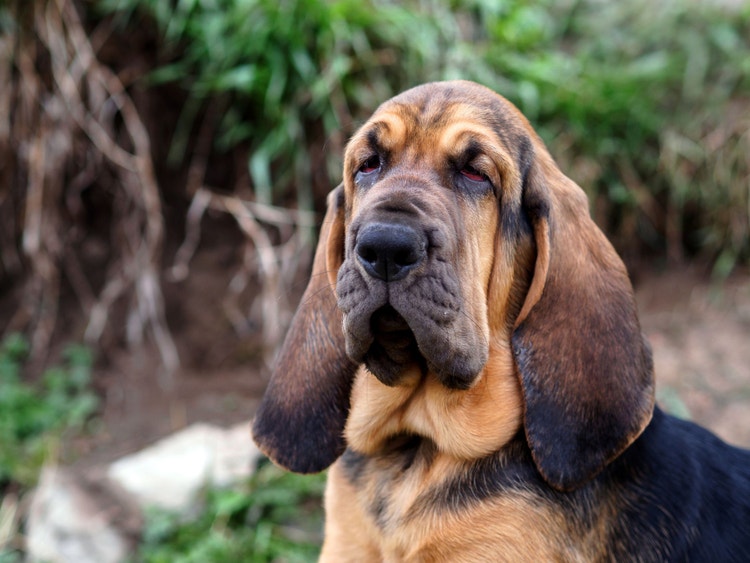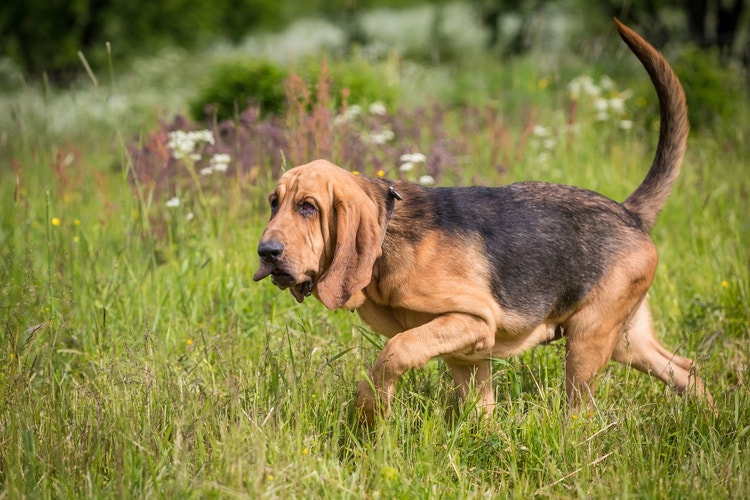
Bloodhound


Where Are Bloodhounds From?
The modern-day Bloodhound is a descendant of hound dogs bred by Saint Hubertus in 7th-century Europe. Hubertus, otherwise known as the Patron Saint of Hunters, established the dark, black & tan-colored dogs, which were known as “St. Hubert’s hounds.” The line is said to have begun at Saint-Hubert Monastery in Belgium, although the exact origin is unknown. Nonetheless, pairs of Bloodhounds were occasionally given as gifts to the King of France. The breed is still referred to as the “Chien de Saint-Hubert” in France today.
In Medieval times, these hound dogs were esteemed for their ability to track prey by scent. Breeding programs at monasteries in France and England were established by senior members of the Christian clergy. It is here that the hounds became known as “blooded,” signifying their noble association.
The exact introduction of Bloodhounds to Northern America may have occurred at The Westminster Kennel Club Dog Show in the late 19th century, when British breeder Edwin Brough displayed three of his hounds, which led to a rise in demand and breeding in America.
In the United States, the Bloodhound is heralded for police work, with the breed primarily being used as expert human-scent trackers.
Caring for a Bloodhound
What Kind of Diet Does a Bloodhound Need?
What Kind of Diet Does a Bloodhound Need?
Bloodhounds need a food specifically formulated for large breeds, but don’t let their size be a license for overeating.
How Much Grooming Does a Bloodhound Need?
How Much Grooming Does a Bloodhound Need?
The Bloodhound’s short coat doesn’t require much grooming, and bathing once a month is more than sufficient. However, their pendulous ears often require weekly cleaning.
Are Bloodhounds Healthy Dogs?
Are Bloodhounds Healthy Dogs?
The Bloodhound is a relatively healthy dog breed with an average life expectancy of 9 – 11 years.
Possible medical issues include gastric dilatation volvulus (the stomach twists on itself and prevents blood from flowing properly throughout the body) and various ocular conditions.
Bloodhounds are predisposed to: gastric dilatation volvulus, hip dysplasia, entropion, ectropion, keratoconjunctivitis sicca, cherry eye, and ear infections.
How Much Training Does a Bloodhound Need?
How Much Training Does a Bloodhound Need?
Bloodhounds, by nature, tend to be determined and strong-willed. This can make training more challenging.
Early obedience lessons, a high-level of patience, and consistent positive rewards are all recommended to ensure a well-behaved Bloodhound from puppyhood.
How Much Exercise Does a Bloodhound Need?
How Much Exercise Does a Bloodhound Need?
Bloodhounds are active dogs that require daily exercise and enrichment. They must always be on a leash or within a well-secured yard, as they will follow their nose without concern for their surroundings when on the trail of a scent.
What Are the Physical Characteristics of a Bloodhound?
Bloodhound Facts
Other Breeds to Explore
References
- American Kennel Club. The Complete Dog Book. Random House Digital, Inc., 2006.
- Morris, Desmond. Dogs: The Ultimate Dictionary of Over 1,000 Dog Breeds. Trafalgar Square, 2002.


